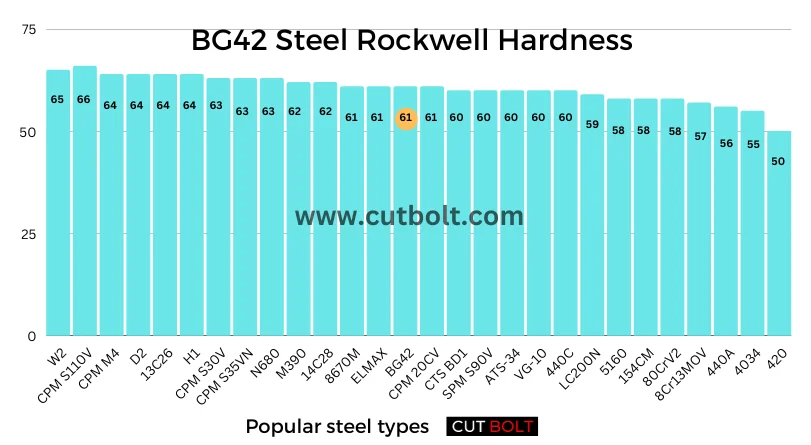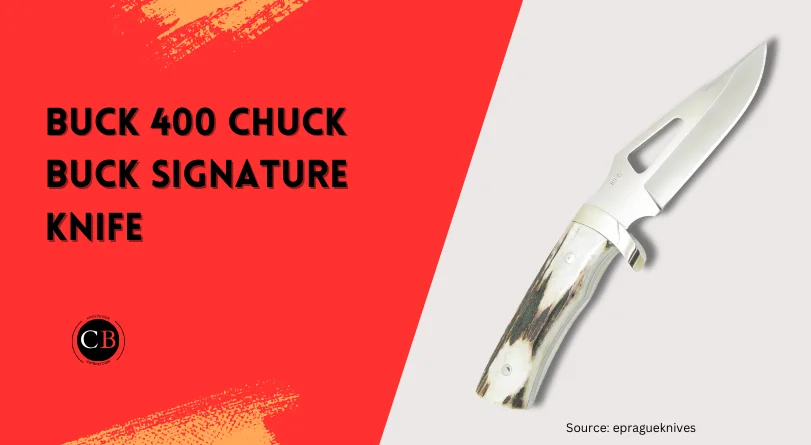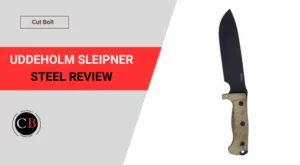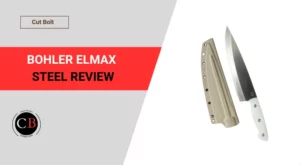For years, my daily carry folder made of the vaunted, yet discontinued, BG42 steel has fueled the question: Is BG42 steel good for knives? As a seasoned collector, I’m here to tell you, it’s not just good, it’s exceptional.
This “unicorn” steel boasted a perfectly balanced alloy, granting it unmatched edge retention and remarkable corrosion resistance. Each cut felt effortless, a testament to the meticulous craftsmanship that honed this workhorse to a rarely matched level.
Newer steels have risen, and scarcity has inflated its price, but my BG42 EDC remains more than just a tool; it’s a relic of a pinnacle in knife-making. It embodies the flawless union of science and art, performance and perfection. A rare breed that continues to inspire the industry even today.
Join me, fellow knife enthusiasts, as we dive deep into the world of BG42 steel. We’ll explore its unique properties, compare it to modern contenders, and answer the question: Is this discontinued legend still a worthy choice for your next blade? Stay tuned!
What is BG42 steel?
BG42, a dual vacuum melted martensitic stainless steel, was originally designed for aerospace components and high-performance bearings. LATROBE developed it, but now CARPENTER produces it under the name CTS-B75P after acquiring LATROBE.
Though this article initially explores the legend of BG42, consider it a sneak peek into the world of its modern successor, the CTS-B75P steel review. We’ll dive into its characteristics, performance, and even compare it to modern steels, helping you decide if this “reborn” legend deserves a place in your next blade.

Chemical composition BG42 steel (CTS-B75P)
| Element | Portion | Effect |
| Chrome | 14.5% | Improves wear resistance, heat resistance and scale resistance. It increases tensile strength because it acts as a carbide former. Use of rust-proof or stainless steel, as it increases corrosion resistance from a mass proportion of 12.2%. Reduction in weldability. |
| Carbon | 1.15% | Increasing hardness and tensile strength. In larger quantities, increase in brittleness and reduction in forgeability and weldability. |
| Manganese | 0.5% | Improves hardness and tensile strength. |
| Molybdenum | 4.0% | Improves hardenability, tensile strength and weldability. Reduction in forgeability and ductility. |
| Silicon | 0.3% | Improves strength. |
| Vanadium | 1.2% | Increasing hardness, increasing wear resistance and improving tempering resistance. |
What actually all these elements do in a knife steel? Here is a snippet that will help you understand better:
- Carbon: The muscle, providing hardness and wear resistance. But be careful, too much can make it brittle, like a hero who lifts too much at the expense of agility.
- Chromium: The shield, granting exceptional corrosion resistance, guarding against rust and stains like an impenetrable force field.
- Iron: The foundation, the core of the steel, providing strength and structure like a hero’s unwavering resolve.
- Manganese: The blacksmith, aiding in hardenability and machinability, making the steel more easily shaped and forged into its final form.
- Molybdenum: The heat shield, ensuring tempering resistance and high-temperature strength, allowing it to stay tough even when things get hot.
- Silicon: The purifier, removing impurities and improving hardenability, like a clean slate for the other elements to shine.
- Vanadium: The armorer, forming hard carbides that contribute to superior wear resistance and edge retention, giving the steel unparalleled sharpness and resilience.
As you can see from the stock and quantity percentages, BG42 steel is a blend that makes it a very tough stainless steel.
What is the hardness (HRC) of BG42 steel?
The hardness of BG42 steel typically falls within the range of 58 to 61 HRC on the Rockwell C scale. But it can vary depending on the heat treatment it receives.
Here’s a breakdown of what this means:
- HRC: Stands for Rockwell Hardness, a common scale for measuring the hardness of materials.
- 58 – 61: This range indicates that BG42 is a very hard steel. For comparison, high-end kitchen knives typically have a hardness around 58-60 HRC, while industrial blades can reach up to 62-64 HRC.
It’s important to note that hardness isn’t the only factor affecting the performance of a knife. Other factors like edge geometry, grind, and steel composition also play a role in edge retention, toughness, and corrosion resistance.

Check the BG42 steel heat treatment process mentioned by Carpenter Technology.
Is BG42 stainless steel?
Yes, BG42 is indeed a stainless steel. This is evident from its chemical composition, specifically the high chromium content (14.5%) and its sulfur and phosphorus content (so-called iron companions) do not exceed 0.025%. Chromium is the key element in stainless steel, as it forms a protective oxide layer on the surface that resists rust and corrosion.
This makes it suitable for various applications where both toughness and corrosion resistance are desired, such as knives, bearings, and aerospace components.

BG42 steel properties
According to its chemical composition and hardness, BG42 offers the following properties:
Key Strengths:
- Excellent Edge Retention: Due to its high carbon and vanadium content, BG42 steel forms very hard carbides, resulting in exceptional edge retention. It stays sharp for long periods, even with heavy use.
- Good Corrosion Resistance: The high chromium content ensures good corrosion resistance, making it suitable for various environments without rusting easily.
- High Hardness: With a typical hardness range of 58-62 HRC, BG42 is a very hard steel, translating to good wear resistance and ability to withstand demanding tasks.
- Good Toughness: While not the toughest steel around, BG42 offers a decent balance between hardness and toughness, making it resistant to chipping and breaking.
- Machinability and Weldability: Despite its high hardness, BG42 is relatively easy to machine and weld, making it versatile for manufacturing knives and other components.
- Wear resistance: this steel has first-class wear resistance.
- Sharpness: the rule is “the harder the steel, the harder it is to sharpen”. BG42 is a hard steel that is not quite as easy to sharpen.
Potential Downsides:
- Discontinued: BG42 is no longer commercially produced by its original manufacturer, LATROBE. While similar steel variants like CTS-B75P exist, true BG42 can be harder to find and more expensive.
- Price: Due to its scarcity and high-performance properties, BG42 knives can be more expensive compared to blades made from readily available steels.
- Sharpening Difficulty: With its high hardness, sharpening BG42 blades requires more specialized tools and techniques compared to softer steels.
Overall:
BG42 is a high-performance steel with exceptional edge retention, good corrosion resistance, and decent toughness. While discontinued, its unique properties make it a highly sought-after material for knives and demanding applications. However, its limited availability and price point require careful consideration before purchase.

Is BG42 a good knife steel?
Yes, BG42 boasts an undeniable legacy as a fantastic knife steel, its status as a discontinued material adds a significant wrinkle to its attractiveness.
On the one hand, its performance speaks for itself. Expect phenomenal edge retention, staying sharp through demanding tasks. The high chromium content translates to excellent corrosion resistance, keeping rust at bay. And its overall toughness ensures it can handle abuse without chipping or breaking.
However, the “catch” lies in its current availability. BG42 is no longer commercially produced, meaning you’ll have to scour the secondary market for used or older knives. This naturally drives up the price, as its scarcity meets its high-performance reputation. Additionally, its hardness translates to a higher difficulty in sharpening, requiring more specialized tools and expertise.
Ultimately, choosing BG42 hinges on your priorities. If a budget-friendly, readily available knife is your goal, other modern steels can deliver admirable performance. But if you possess the budget, patience for the hunt, and sharpening skills, a BG42 could be a truly exceptional, albeit hard-won, addition to your collection.
As earlier we have mentioned that BG42 has been discontinued and CARPENTER produces it under the name CTS-B75P, it is beneficial to know if CTS-B75P is a good steel for making knives.

Is CTS-B75P steel good for making knives?
CTS-B75P steel walks a tightrope between legend and reality. In theory, it’s the spiritual successor to the revered BG42, known for its phenomenal edge retention, excellent corrosion resistance, and impressive toughness. However, the reality is slightly more nuanced.
It offers a similar performance to BG42, holding its edge superbly and shrugging off rust with ease. Its toughness ensures it can handle demanding tasks without chipping or breaking. The catch? It’s technically a different steel, and some users report subtle performance variations compared to the legendary BG42. Additionally, it shares BG42’s scarcity, potentially impacting price and availability.
So, is CTS-B75P good for knives? Absolutely! It lives up to the BG42 legacy in many ways, making it a fantastic choice for demanding use. However, be prepared for potential price premiums and slight performance differences compared to its mythical predecessor. If budget and absolute authenticity aren’t your top concerns, CTS-B75P can be a truly exceptional blade steel.

BG42 steel equivalent
CPM S30V steel is the closest to BG42/CTS-B75P steel in terms of corrosion resistance, hardness, wear resistance and toughness.
Both are top-of-the-line stainless steels that resist rust, stay sharp for ages, and can handle tough tasks without chipping. Basically, they’re both rockstars!
But here’s the kicker: S30V wins the “easy to sharpen” award, even though it’s just as hard and tough. This means you can keep it razor-sharp without needing fancy tools or skills.
So, if you want a knife that’s super strong, rust-resistant, and stays sharp forever, but don’t want to struggle with sharpening, S30V is the way to go! It might even be better than the old BG42 in this respect.
Related: K390 knife steel review
Conclusion: Is BG42 steel good for knives?
Writing this article was a bit of a different experience, after all, I was dealing with a “ghost steel” so to speak, that has effectively disappeared from the market.
Nevertheless, it is interesting to follow the developments and compare them with the new and latest generation of high-tech steels (S30V, S90V…) available today, which combine properties that were unthinkable 2 or 3 decades ago.
Nevertheless, collectors who want to own a BG42 knife have to dig deep into their pockets. If it is only about the properties, and the price-performance ratio, then you are probably best served with an S30V knife, because even CTS-B75P knives have significantly higher prices.



